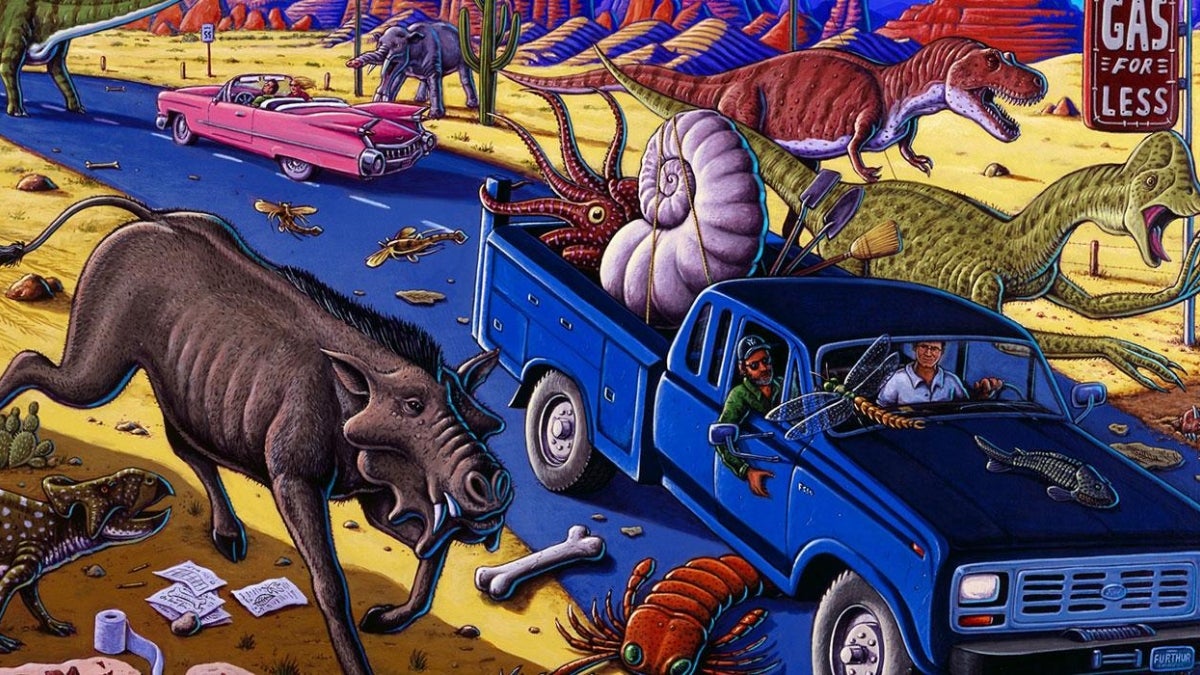Exhibit takes whimsical road trip down 'Fossil Freeway'

"Cruisin’ the Fossil Freeway" with artist Ray Troll and paleontologist Kirk Johnson.
Road-tripping across the American West is a beloved tradition — blacktop snaking across badlands, roadside tourist traps and great diners.
Imagine experiencing it with a paleontologist prone to picturing pterodactyls perched on last-chance gas stations and an artist who plucks giant dragonflies off the pickup windshield.
A new exhibit at the Arizona State University Natural History Collection combines a whimsical art exhibit with the gems of the fossil collection to offer an opportunity to learn about evolution, extinction, geology and paleontology.
“Cruisin’ the Fossil Freeway” was created by paleontologist Kirk Johnson and artist Ray Troll after they traveled 5,000 miles though the American West, searching for fossils, fossil finders, good stories and the perfect diner cheeseburger.
Troll’s art conjures R. Crumb, if he were trapped in Jurassic Park. He combines humor with accuracy. Yes, he is plucking a giant prehistoric dragonfly off the pickup windshield, but the 2-foot wingspan of M. permiana is as it was.
Nineteen framed color prints depict scenes like dinosaurs running through traffic, car lots and convenience stores. The message: You can find fossils anywhere, even in a cut bank behind a burger joint.
In “Dinosaur Highway,” a late-night view from a truck cab reveals a brontosaurus caught in the headlights.
“Driving around the American West and thinking about dinosaurs, Ray and Kirk often imagined what it would be like to encounter a real dinosaur on the hoof,” read the explanatory note for the painting. “Listening to late-night rock-and-roll radio after driving 400 miles in one day was the best time to spot those imaginary roadside creatures.”
ASU paleobotanist Kathleen Pigg knows both the scientist and the artist. She was instrumental in bringing the exhibit to the university.
Troll’s “art really appeals to people of all ages,” she said.
Several of Pigg’s specimens are featured in the exhibit. She primarily studies plant fossils from the past 65 million years in western North America. Her research team investigates the evolution, biogeographic distribution and adaptations of major flowering plant groups. They collect fossilized fruits, seeds, flowers and leaves and compare them with those of modern relatives.
“We do our own collecting,” she said. “I tend to do a lot of my collecting in the basement of a museum.”
Paleobotanists are few and far between, Pigg said. “We all tend to know each other,” she said. “We don’t get quite the press the dinosaurs do.”
Other fossils from ASU’s collection include three hadrosaurid eggs the size of huge grapefruit and two oviraptor eggs as big as half a sub sandwich. Teeth the length of a man’s hand sit beneath a painting of everything that has ever had saber teeth.
The plethora of fossils across the West is illustrated in the Ultimate Paleo Road Map. It features the main roads Johnson and Troll traveled along, packed with whimsical pteranodons flying over puzzled cows, Wall Drug’s dinosaur in South Dakota, the Teenage Mammoth Mosh Pit of Death, and the world’s largest prairie dog in Oakley, Kansas.
Everywhere ammonites, plesiosaurs, dinohyus (“the Terminator Pig”) uintatheres (knobby-headed saber-toothed herbivores) run and snarl, bite and yawn, scratch and chase cars.
Makes you want to pick up a bucket of fried chicken and head to Delta, Utah, “where trilobites are kings.”
‘Cruisin’ the Fossil Freeway’ exhibit
Where: 734 W. Alameda Drive, Tempe.
When: 9 a.m.-5 p.m. Tuesdays and Thursdays through Dec. 15.
Public talks: Reception begins at 5:30 p.m., the talk at 6:30 p.m.
• Sept. 28: Peter Wilf, paleobotanist, Pennsylvania State University
• Oct. 19: Bruce Archibald, paleoentomologist, Simon Fraser University
• Nov. 16: Jack Nisbet, naturalist and writer